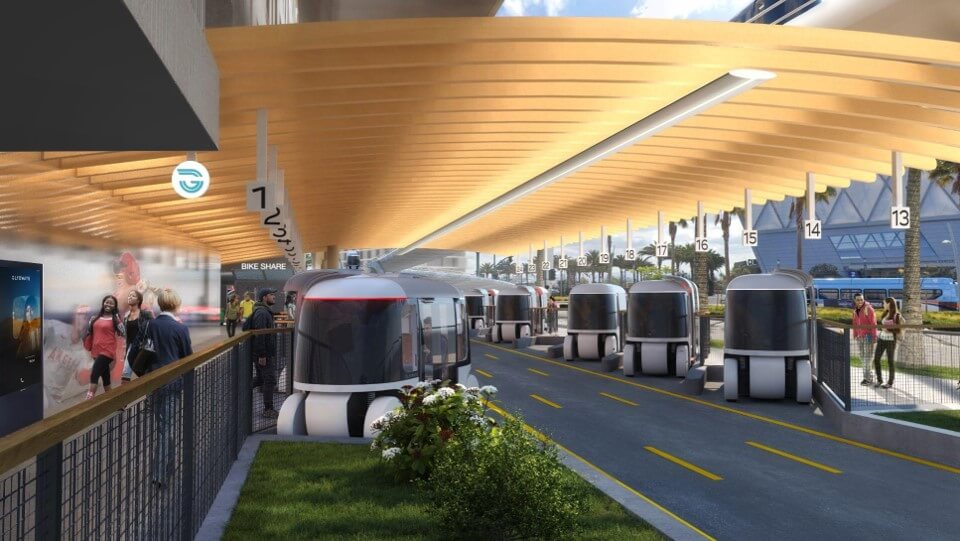Innovation Spotlight, Project News
Bridging the Gap: The Case for Personal Rapid Transit Systems

As costs soar to expand and maintain traditional public transit, it’s time to reimagine an innovative solution from the past.

By Brian Gettinger
Flatiron Vice President of Project Development
Access to reliable, safe and efficient transportation directly correlates with economic opportunity. Studies have shown that reliable transportation to and from work is the biggest contributor to upward social and economic mobility.
Existing transit systems (except those in the densest urban areas) are at times poorly utilized, expensive to operate and unable to offer attractive services to transit-dependent users and riders by choice alike.
Expansion and/or extension of traditional transit services (light rail, subway, heavy rail, bus rapid transit and traditional bus service) can encourage ridership, but the expense often has been cost-prohibitive. Price tags have also ballooned in the wake of the COVID-19 pandemic. Additionally, competition for federal funding is intense, further limiting the number of new and extended services that can be implemented.
A Future Solution Rooted in the Past

West Virginia University’s Personal Rapid Transit system
Because of these factors, the market is eager for a solution that offers fast, safe and reliable transportation that can be deployed quickly and at a lower cost than traditional modes. Now is the time to refresh an often-overlooked transit solution first built nearly 50 years ago at an unexpected place, West Virginia University. The WVU Personal Rapid Transit System, originally built in 1975, moves approximately 12,000 passengers daily using a fleet of more than 60 automated vehicles with around 20-person capacity along a 3.6-mile dedicated guideway with offline stations. The university says more than 83 million passengers have been on the all-electric PRT since its debut, taking countless vehicles off busy streets.
Fast forward to 2024: parallel advances in vehicle technology, automation, batteries and computing power have set the stage for a PRT-systems renaissance. Although autonomous vehicles haven’t ubiquitously proven themselves ready to tackle mixed traffic on roads, the technology is ready for deployment when a dedicated guideway is provided.
PRT systems on a dedicated guideway also offer strong sustainability benefits. They attract ridership from less sustainable modes and have no emissions with 100% battery-power. In addition, because the vehicles are not physically attached to the guideway, future vehicle replacements with upgraded technology can be made without additional capital costs.
Dedicated PRT guideway systems can provide transit-level ridership capacity at a fraction of the cost of traditional transit systems due to their smaller size and lighter weight. PRT systems like Glydways, Oceaneering, Modutram and Swyft Cities offer a personalized and express rider experience in sharp contrast with a packed subway train, encouraging uptake from all riders.

Courtesy: Oceaneering
With reduced guideway costs, PRTs can potentially address a large untapped mobility market where traditional transit solutions aren’t feasible—large campuses and urban areas without fixed transit service. In addition, there are opportunities to extend the reach of existing transit systems with last-mile or more extensions.
Flatiron’s Commitment to Growing PRT Systems
Flatiron has partnered with Glydways and Plenary to develop a PRT system to extend Bay Area Rapid Transit service and provide community mobility in the East Bay outside of San Francisco for the Contra Costa Transportation Authority. The East County Automated Transit Network will initially extend BART service access to Antioch and Brentwood, a long-planned extension that was economically non-viable with the existing technology. The project will have a broader expansion through Pittsburgh and other surrounding communities as well.
Beyond Northern California, there are intriguing opportunities for PRT deployment at small to mid-size airports that serve around 10 million passengers a year. These airports struggle to afford traditional automated people movers that connect the terminal to rental cars, long-term parking, employee parking and connection to other transit systems. A dedicated guideway PRT system can offer the convenience and reliability of an APM at a price that is affordable for a small to mid-sized airport.
